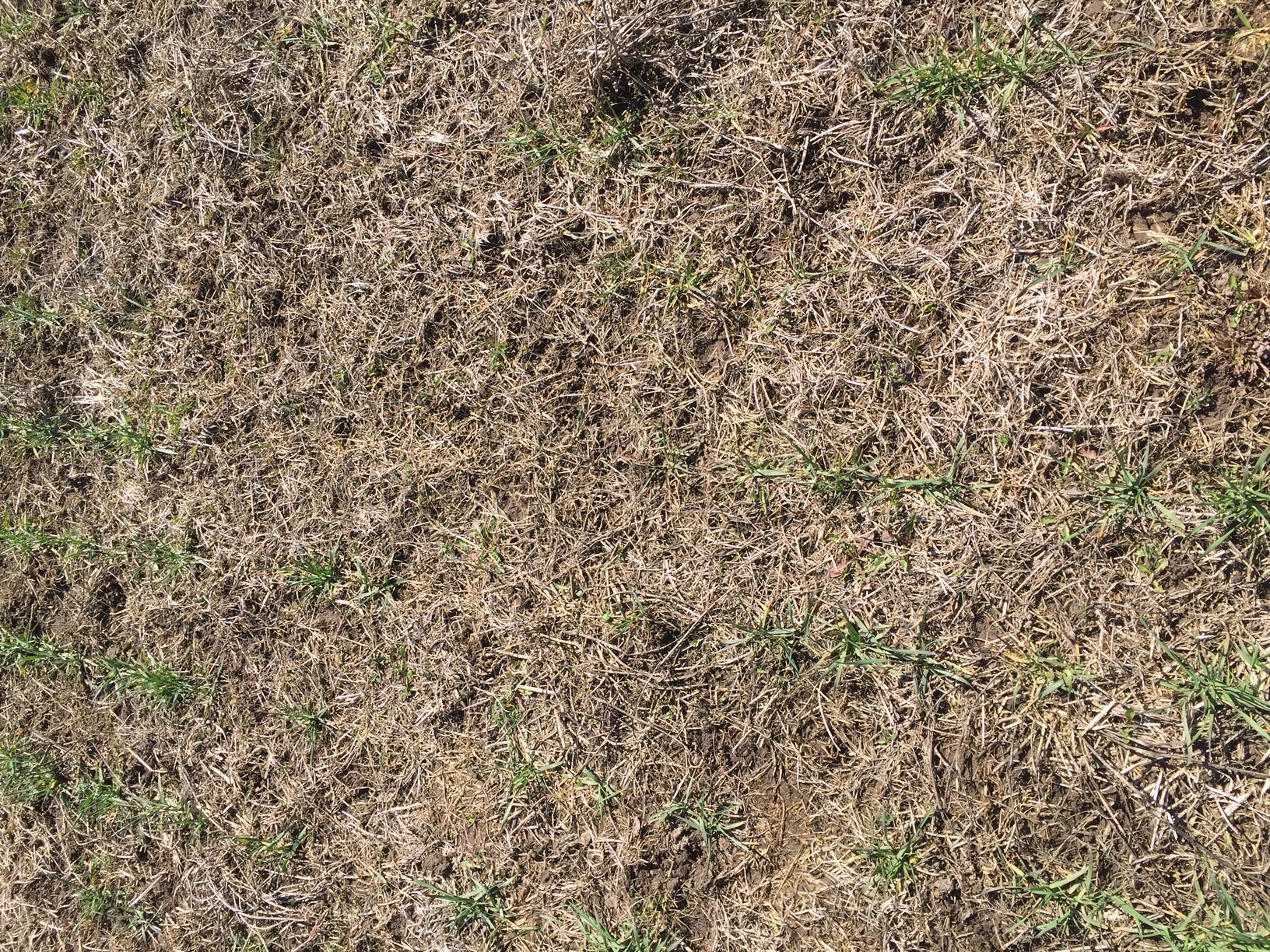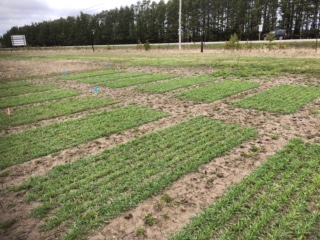What seemed like an early spring for northern producers has become a more typical spring as conditions have remained cool. Aside from a brief window after the last meeting, there hasn’t been much field work done in the past two weeks.
Our next meeting is on May 19th at 8:30am, and we will hear from Ben Rosser, Corn Specialist, and Christine O’Reilly, Forage and Grazing Specialist.
Weed Control
Mike Cowbrough, Weed Specialist, shared general information on weed control and details for managing wild oats. A good weed control program for spring cereals starts with good soil fertility. When soil phosphorous and potassium levels are, respectively, 20 ppm and 120 ppm or greater, spring cereal canopies close faster which can help reduce weed emergence. Planting as early as possible also helps get the crop emerged earlier than weeds.
In the past, good wild oat control could be achieved with post-emergence application of Group 1 herbicides (such as Puma and Achieve) but over time populations of wild oats developed resistance to Group 1 herbicides. Newer herbicides can provide effective control but can injure barley. A layered or multi-pass approach is recommended to manage the weed. Pre-emergence products can (e.g. Avadex, Focus) significantly knock back the population of wild oats, and following up with a Group 1 or Group 2 herbicide postemergence provides further control. There is no perfect system, and you often have to “chip away” at the wild oat pressure.
François Tardif (University of Guelph) is leading a team who are now looking at strategies to manage wild oats in barley and spring wheat. They are also collecting samples from farm fields to determine what biotypes of wild oats are present and what herbicides they are resistant to. There are 3 on farm trials, one of which is in the New Liskeard area. Results from 5 samples of wild oats collected last year show that all were resistant to Group 1 herbicides, some were resistant to Group 2 herbicides (such as Vero and Simplicity) and some were resistant to herbicides in both groups. More information on wild oat management can be found at the Wild Oat Action Committee information page: https://weedscience.ca/wild-oat-action-committee/
Producers are encouraged to contact Mike Cowbrough for help identifying weeds. You can send high quality photos and/or send dried plant samples in a paper envelope. Dried tissue samples, including weeds found in hay bales or in tiles, can be identified with DNA testing. For some weed species, herbicide resistance can also be confirmed by looking at the DNA taken from dried leaf samples. For other weeds, including wild oats, seeds must be collected from mature plants to conduct a “field bioassay” to test for herbicide resistance. Ideally, seed would be collected from a few areas of the field, and the more seed, the better. Frozen or rotting samples often cannot be used, so dry samples in the sun and store in paper envelopes or bags rather than plastic. Results will be kept confidential. At this time, DNA testing can be done for free.
A grower commented that perennial sow thistle pressure seemed very high last year and wondered about the presence of resistance to MCPA. Cowbrough quoted an old saying, “if you kill it in May it grows back in a day, if you kill it in June, it’s too soon. If you kill it in July, then it will die”. When you burn off Canada thistle or sow thistle shoots in spring that are emerging from rhizomes they grow back quickly because they are investing all their energy toward producing seed. Once they start to flower, they allocate resources to storing energy and are easier to control. There will be better success with whittling down sow thistle populations if management is targeted to late summer or early autumn when herbicide can be transported down to the roots. Different populations, or biotypes, may respond differently to management. It was noted that Lontrel XC can provide good control of sow thistle and is now a more cost-effective option. Canada thistle and perennial sow thistle are some of the weeds included in the Problem Weed Guide found HERE.
Another participant noted that they have had difficulty controlling foxtail species in spring cereals. They are not observing the weeds in spring, but by first of August populations are very high. A two-pass system is recommended, starting with a soil-applied product for early season control. With later flushes foxtail plants will be at all different growth stages and can be quite dense. Good control is achieved when herbicide applications are made prior to the 6-leaf stage. When foxtail has tillered, or when conditions are dry, it can be tough to control.
Sandhill Cranes
Some demonstrations are being run on Avipel, a repellant product for managing sandhill cranes. Cranes typically feed on corn until about the 3-leaf stage. Avipel is used as a seed treatment on corn seed. In potatoes, cranes root around and pick at tubers and expose the tubers to sunlight which causes quality issues. In potatoes, Avipel is sprayed on the crop pre-harvest. The product is a naturally occurring, non-toxic compound and is widely registered in the US. It causes a gut reaction in birds that encourages cranes to forage elsewhere. The product is being pursued for registration in Canada.
Farm Safety
The group took a moment to acknowledge that a child was fatally injured in an on-farm incident on a northern Ontario farm. This is a heartbreaking reminder that we all need to assess our safety practices and communicate with children and farm visitors about safety. With children at home during this lockdown it may be extra important to have these conversations with children now. Some messages that can be shared with children are to never play in grain wagons or grain storage, never play around manure pits, and if they see equipment moving to stand against a building or tree that the equipment driver can see and will avoid. Producers who have tenants renting farm properties should be clear about the boundaries of the rental property and the spaces that tenants should not be accessing for safety reasons. Some links are provided below on various farm safety resources, checklists, and procedures.
- Visitor orientation
- Spring Checklist
- Safe Play Areas on Farms
- Road Safety Webinar
- Bin Safety
- Farm Safety
- Mental Health Resources
Conditions and Updates by Region
Cochrane District: During the meeting it was only 1°C and some snow was falling. There has been very little activity since the last meeting. A few have been getting on the land where they can find a dry field. Timothy and hay are starting to green up but not really growing yet. Next week will be above 10°C but rain is expected. It looks like most field activities will happen in June, as per usual.
Temiskaming District: Activity has stalled due to rains every other day, and a comment was made that they are now getting the typical April weather in May. Some seeding was conducted in the past 2 weeks, maybe around 25% but it’s hard to say. Some pre-plant herbicides have been applied to corn ground recently. Alfalfa is close to fungicide timing. At the Ontario Crops Research Station in New Liskeard, some cereals have been seeded and fertilizer has been applied. The footings for their new building are being completed.
Nipissing District: In the Verner area they are about 7-10 days more advanced than Temiskaming. Fungicides were applied to alfalfa last week and cereals are fully emerged. Not much canola has been seeded yet.
Manitoulin Island: They thought it was an early spring, but now it does not seem like things are ahead of schedule. After the last meeting there was a small window and 10-15% of cereals were seeded, but since then cool weather has stalled progress.
Below are some photos of winter cereal trials. The winter barley is more thin and yellow than plots of winter triticale and winter wheat.
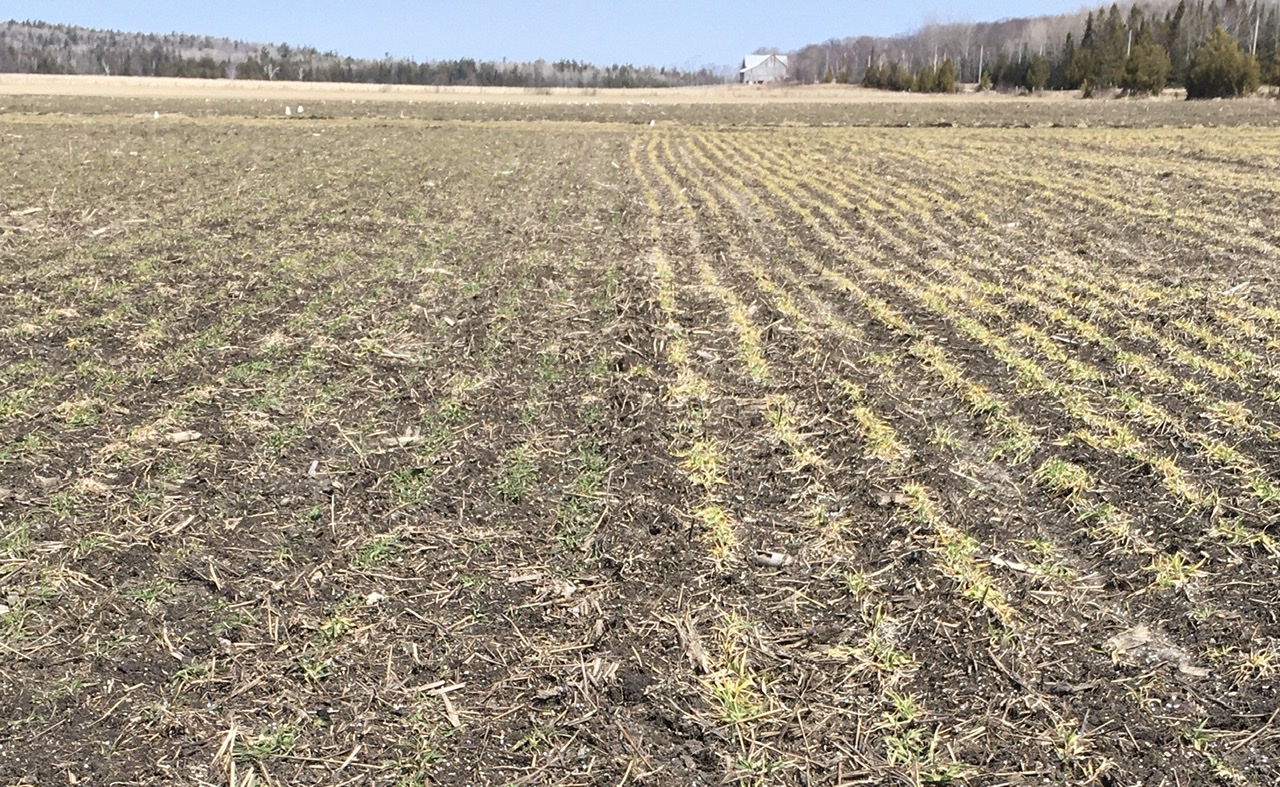

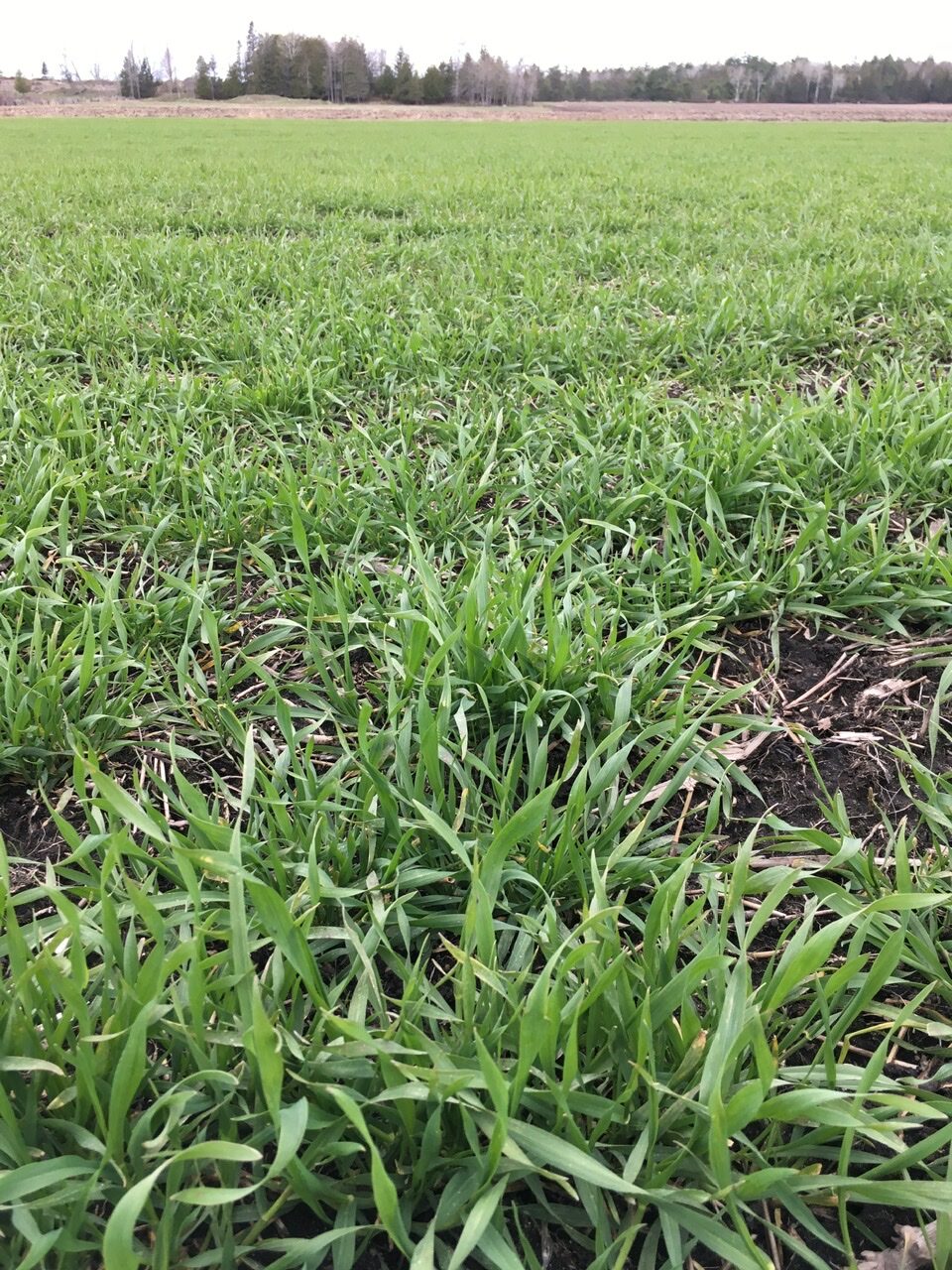
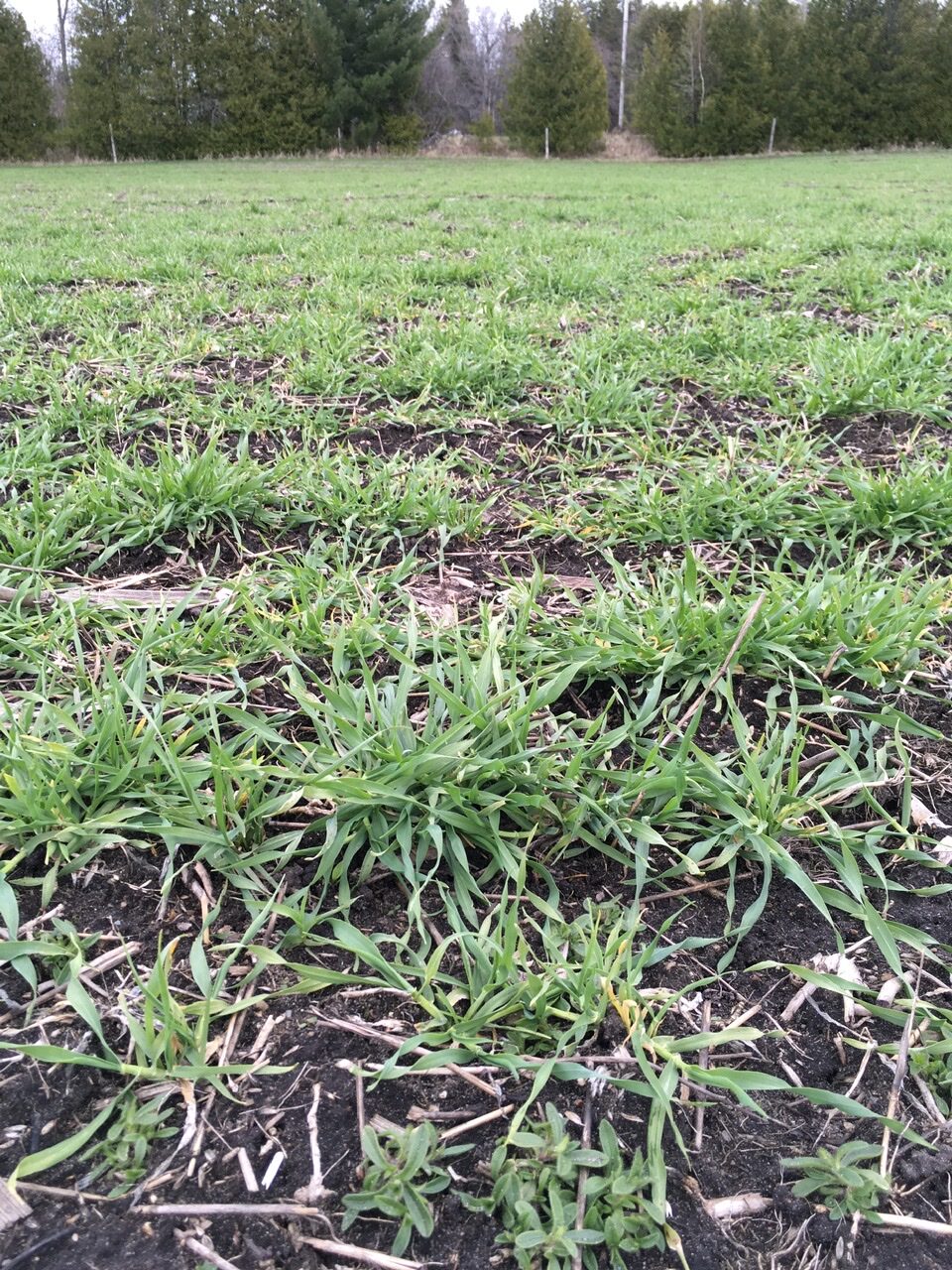
Algoma District: Only a few no-till fields have been planted and conditions have been cool. Hay fields have been fertilized and look healthy, with good winter survival.
Rainy River District: Temperatures on the weekend were above 20°C and a lot of field work was done. Conditions are not wet, but there was 4 mm of rain Monday and frost the morning of the meeting. Forage growth has been slow.
Thunder Bay District: Fertilizer and manure have been applied to fields but planting has been limited. Next week looks warmer but there will be some rain. Seeding should start at the Lakehead University Agriculture Research Station next week. Below are some photos of winter cereals on the station and on local farms.

